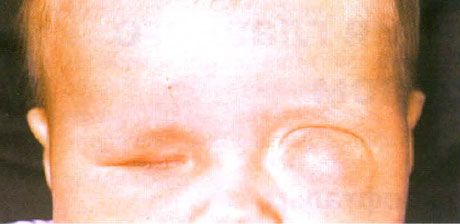Anophthalmos
Last reviewed: 23.04.2024

All iLive content is medically reviewed or fact checked to ensure as much factual accuracy as possible.
We have strict sourcing guidelines and only link to reputable media sites, academic research institutions and, whenever possible, medically peer reviewed studies. Note that the numbers in parentheses ([1], [2], etc.) are clickable links to these studies.
If you feel that any of our content is inaccurate, out-of-date, or otherwise questionable, please select it and press Ctrl + Enter.
The term "anophthalmus" is used in the absence of the eye. Perhaps the presence of a significantly reduced in size, barely discernible rudimentary eyeball. There are many transitional states from microphthalmos to anophthalmos.
- As a rule, the pathology is sporadic in character, the cause of its occurrence is not known. Group cases of appearance of this anomaly are described.
- It can be manifested as an extreme degree of microphthalmia, in families with colobomous microphthalmos.
- Adverse effects of the external environment, such as X-ray exposure, taking drugs during pregnancy (LSD); At the same time, as a rule, it is not possible to identify the main factor provoking the appearance of this pathology.

Clinical examination
It is necessary to examine the child in order to detect the presence of residual light perception, for example, in the form of a start-reflex to a photographic flash. To study the residual function, it is also expedient to study visual evoked potentials (VEP). The need to increase the volume of the orbit is determined by estimating its size and shape. If the pathology is one-sided, carefully examine the pair eye.
Survey parents, brothers and sisters of a sick child to exclude the presence of a colobus.
What do need to examine?
Anophthalmic treatment
Stimulation of orbit growth with the help of orbital implants, eye prostheses, gradually increasing in size and, in older children, surgical intervention.
Early onset of pleoptical treatment with any residual vision, timely stimulation of general development and choice of the optimal form of education for a sick child.


 [
[